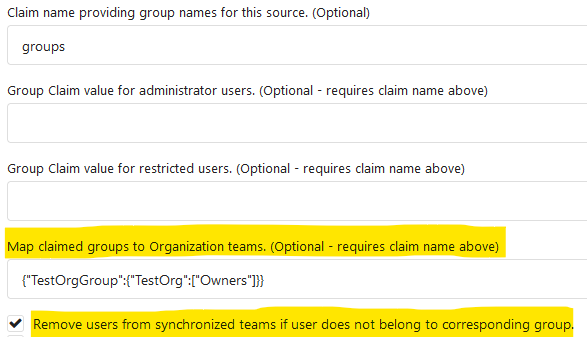Fixes #19555 Test-Instructions: https://github.com/go-gitea/gitea/pull/21441#issuecomment-1419438000 This PR implements the mapping of user groups provided by OIDC providers to orgs teams in Gitea. The main part is a refactoring of the existing LDAP code to make it usable from different providers. Refactorings: - Moved the router auth code from module to service because of import cycles - Changed some model methods to take a `Context` parameter - Moved the mapping code from LDAP to a common location I've tested it with Keycloak but other providers should work too. The JSON mapping format is the same as for LDAP.  --------- Co-authored-by: Lunny Xiao <xiaolunwen@gmail.com> |
||
|---|---|---|
| .. | ||
| assert_interface_test.go | ||
| README.md | ||
| security_protocol.go | ||
| source.go | ||
| source_authenticate.go | ||
| source_search.go | ||
| source_sync.go | ||
| util.go | ||
Gitea LDAP Authentication Module
About
This authentication module attempts to authorize and authenticate a user against an LDAP server. It provides two methods of authentication: LDAP via BindDN, and LDAP simple authentication.
LDAP via BindDN functions like most LDAP authentication systems. First, it queries the LDAP server using a Bind DN and searches for the user that is attempting to sign in. If the user is found, the module attempts to bind to the server using the user's supplied credentials. If this succeeds, the user has been authenticated, and his account information is retrieved and passed to the Gogs login infrastructure.
LDAP simple authentication does not utilize a Bind DN. Instead, it binds directly with the LDAP server using the user's supplied credentials. If the bind succeeds and no filter rules out the user, the user is authenticated.
LDAP via BindDN is recommended for most users. By using a Bind DN, the server can perform authorization by restricting which entries the Bind DN account can read. Further, using a Bind DN with reduced permissions can reduce security risk in the face of application bugs.
Usage
To use this module, add an LDAP authentication source via the Authentications section in the admin panel. Both the LDAP via BindDN and the simple auth LDAP share the following fields:
-
Authorization Name (required)
- A name to assign to the new method of authorization.
-
Host (required)
- The address where the LDAP server can be reached.
- Example: mydomain.com
-
Port (required)
- The port to use when connecting to the server.
- Example: 636
-
Enable TLS Encryption (optional)
- Whether to use TLS when connecting to the LDAP server.
-
Admin Filter (optional)
- An LDAP filter specifying if a user should be given administrator privileges. If a user accounts passes the filter, the user will be privileged as an administrator.
- Example: (objectClass=adminAccount)
-
First name attribute (optional)
- The attribute of the user's LDAP record containing the user's first name. This will be used to populate their account information.
- Example: givenName
-
Surname attribute (optional)
- The attribute of the user's LDAP record containing the user's surname This will be used to populate their account information.
- Example: sn
-
E-mail attribute (required)
- The attribute of the user's LDAP record containing the user's email address. This will be used to populate their account information.
- Example: mail
LDAP via BindDN adds the following fields:
-
Bind DN (optional)
- The DN to bind to the LDAP server with when searching for the user. This may be left blank to perform an anonymous search.
- Example: cn=Search,dc=mydomain,dc=com
-
Bind Password (optional)
- The password for the Bind DN specified above, if any. Note: The password is stored in plaintext at the server. As such, ensure that your Bind DN has as few privileges as possible.
-
User Search Base (required)
- The LDAP base at which user accounts will be searched for.
- Example: ou=Users,dc=mydomain,dc=com
-
User Filter (required)
- An LDAP filter declaring how to find the user record that is attempting to authenticate. The '%s' matching parameter will be substituted with the user's username.
- Example: (&(objectClass=posixAccount)(uid=%s))
LDAP using simple auth adds the following fields:
-
User DN (required)
- A template to use as the user's DN. The
%smatching parameter will be substituted with the user's username. - Example: cn=%s,ou=Users,dc=mydomain,dc=com
- Example: uid=%s,ou=Users,dc=mydomain,dc=com
- A template to use as the user's DN. The
-
User Search Base (optional)
- The LDAP base at which user accounts will be searched for.
- Example: ou=Users,dc=mydomain,dc=com
-
User Filter (required)
- An LDAP filter declaring when a user should be allowed to log in. The
%smatching parameter will be substituted with the user's username. - Example: (&(objectClass=posixAccount)(cn=%s))
- Example: (&(objectClass=posixAccount)(uid=%s))
- An LDAP filter declaring when a user should be allowed to log in. The
Verify group membership in LDAP uses the following fields:
-
Group Search Base (optional)
- The LDAP DN used for groups.
- Example: ou=group,dc=mydomain,dc=com
-
Group Name Filter (optional)
- An LDAP filter declaring how to find valid groups in the above DN.
- Example: (|(cn=gitea_users)(cn=admins))
-
User Attribute in Group (optional)
- Which user LDAP attribute is listed in the group.
- Example: uid
-
Group Attribute for User (optional)
- Which group LDAP attribute contains an array above user attribute names.
- Example: memberUid
-
Team group map (optional)
- Automatically add users to Organization teams, depending on LDAP group memberships.
- Note: this function only adds users to teams, it never removes users.
- Example: {"cn=MyGroup,cn=groups,dc=example,dc=org": {"MyGiteaOrganization": ["MyGiteaTeam1", "MyGiteaTeam2", ...], ...}, ...}
-
Team group map removal (optional)
- If set to true, users will be removed from teams if they are not members of the corresponding group.

